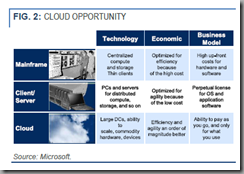Economics - it’s What Drives the Shift to the Cloud
 Economics is often called the inexact science, but it provides the driving force behind the transition to the cloud. It is similar to previous technology change such as the move from centralized to client/server to virtualization. Customers and have deployed virtualization within their environments to address key economic/budgetary issues of under-utilization and power consumption. My local power utility was providing tax rebates for virtualization projects in the past. Business units and developers have subscribed to SaaS and IaaS solutions to increase business agility and flexibility. IT departments are under pressure to deliver services similar to cloud providers – not just once, but to have repeatable processes.
Economics is often called the inexact science, but it provides the driving force behind the transition to the cloud. It is similar to previous technology change such as the move from centralized to client/server to virtualization. Customers and have deployed virtualization within their environments to address key economic/budgetary issues of under-utilization and power consumption. My local power utility was providing tax rebates for virtualization projects in the past. Business units and developers have subscribed to SaaS and IaaS solutions to increase business agility and flexibility. IT departments are under pressure to deliver services similar to cloud providers – not just once, but to have repeatable processes.
I would highly recommend reading “The Economics of the Cloud” white paper authored by Rolf Harms and Michael Yamartino of Microsoft. Their thesis is that the economic advantage will drive transition to the public cloud. In particular, they outline these key advantages:
- Supply-Side savings – large clouds can purchase and operate infrastructure more efficiently
- Demand-Side savings – large clouds can efficiently pool users AND Multi-Tenancy – The ability share an application across many customers – splits the cost of managing that application to all customers as well
In “The Economics of the Cloud” the authors discuss how those three advantages affect private and public clouds and the trade-offs that it creates for IT leaders. Private clouds can address many of the concerns that IT has about cloud computing, and they may be suitable for certain situations, but they have limited ability to leverage Demand-Side savings of Multi-Tenancy and operational efficiency.